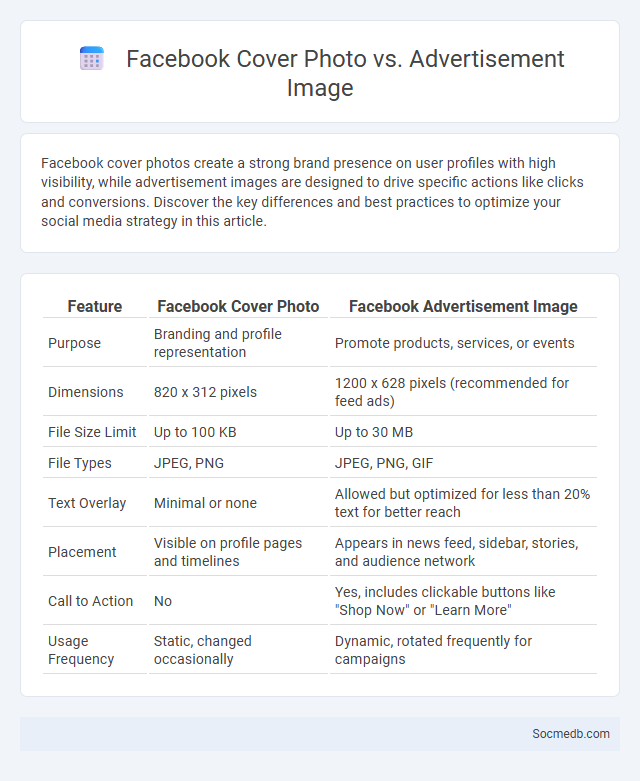
Photo illustration: Facebook Cover Photo vs Advertisement Image
Facebook cover photos create a strong brand presence on user profiles with high visibility, while advertisement images are designed to drive specific actions like clicks and conversions. Discover the key differences and best practices to optimize your social media strategy in this article.
Table of Comparison
| Feature | Facebook Cover Photo | Facebook Advertisement Image |
|---|---|---|
| Purpose | Branding and profile representation | Promote products, services, or events |
| Dimensions | 820 x 312 pixels | 1200 x 628 pixels (recommended for feed ads) |
| File Size Limit | Up to 100 KB | Up to 30 MB |
| File Types | JPEG, PNG | JPEG, PNG, GIF |
| Text Overlay | Minimal or none | Allowed but optimized for less than 20% text for better reach |
| Placement | Visible on profile pages and timelines | Appears in news feed, sidebar, stories, and audience network |
| Call to Action | No | Yes, includes clickable buttons like "Shop Now" or "Learn More" |
| Usage Frequency | Static, changed occasionally | Dynamic, rotated frequently for campaigns |
Understanding Facebook Cover Photos
Facebook cover photos are a vital part of your profile, measuring 820 x 312 pixels on desktop and 640 x 360 pixels on mobile to ensure optimal display across devices. Effective cover photos should reflect your personal brand or business identity while maintaining high resolution and clear focal points around the center to avoid cropping issues. Your cover photo can significantly impact visitors' first impressions, making it essential to balance visual appeal with relevant messaging.
What Is an Advertisement Image on Facebook?
An advertisement image on Facebook is a visual asset used to capture attention and convey a brand message within paid social media campaigns. These images must adhere to Facebook's ad guidelines, including recommended dimensions of 1200 x 628 pixels for single image ads, and optimized content that drives engagement or conversions. Effective Facebook ad images combine compelling visuals with clear calls to action to maximize click-through rates and improve ad performance metrics.
Key Differences Between Cover Photos and Advertisement Images
Cover photos serve as the primary visual representation of a social media profile, designed to establish brand identity and create an immediate impression, typically appearing at the top of user profiles. Advertisement images, on the other hand, are created specifically for marketing campaigns, optimized with clear calls to action and targeted messaging to drive engagement, clicks, or conversions. While cover photos emphasize aesthetics and brand consistency without overwhelming text, advertisement images prioritize impactful visuals combined with persuasive content tailored to audience segments.
Purpose and Goals of a Facebook Cover Photo
Your Facebook cover photo serves as a visual representation of your brand or personality, capturing the attention of visitors within seconds. It strategically communicates your purpose by highlighting your message, values, or promotions, helping to establish a strong first impression. Optimizing your cover photo's design and content aligns with your marketing goals, such as increasing engagement, driving traffic, or enhancing brand recognition.
Design Best Practices for Advertisement Images
Effective social media advertisement images prioritize high-resolution visuals that capture attention instantly while maintaining brand consistency through color schemes and typography. Incorporating minimal text enhances readability on mobile devices, with a recommended maximum of 20% text coverage to comply with platform guidelines and boost engagement. Clear focal points and balanced compositions guide viewer focus, increasing click-through rates and overall ad performance.
Visual Impact: Cover Photo vs. Advertisement Image
The visual impact of a cover photo is crucial for brand identity, serving as the first impression on social media profiles with high-resolution images sized optimally for platforms like Facebook (820 x 312 pixels) and LinkedIn (1128 x 191 pixels). Advertisement images, however, prioritize engagement and conversion, requiring vibrant, clear visuals often combined with call-to-action elements, optimized for varying ad formats such as Instagram Stories (1080 x 1920 pixels) and Facebook Feed (1200 x 628 pixels). Effective use of contrasting colors, focal points, and minimal text enhances both cover photos and ad images, driving user attention and interaction metrics.
Branding Opportunities: Which Image Delivers Better Results?
Visual consistency in social media branding significantly enhances audience recognition and trust, with high-quality, authentic images delivering better engagement than generic visuals. Data from multiple studies indicate that posts featuring professional brand imagery generate up to 94% more views and 150% higher interaction rates compared to standard stock photos. Leveraging branded images tailored to target demographics efficiently amplifies message retention and conversion rates across platforms like Instagram, Facebook, and LinkedIn.
Guidelines and Restrictions: Facebook Cover vs. Ads
Facebook cover photos must adhere to strict guidelines, including a recommended size of 820 x 312 pixels and no text covering more than 20% of the image, ensuring optimal display and compliance. In contrast, Facebook ads offer more flexibility with dimensions and allow higher text coverage, but they must follow advertising policies prohibiting misleading content and promoting community standards. Understanding these distinctions helps you create compliant visual content that maximizes engagement without risking account penalties.
Case Studies: Effective Use of Both Image Types
Case studies reveal that integrating both high-quality photographs and engaging illustrations on social media enhances audience engagement and brand storytelling. Visual content combining real-life images with custom graphics increases click-through rates by up to 45%, as documented in marketing campaigns for major brands like Nike and Airbnb. Your social media strategy can leverage this powerful mix to boost visibility and foster stronger emotional connections with followers.
Choosing the Right Image for Maximum Engagement
Selecting the right image for social media significantly boosts engagement by capturing attention and conveying your message effectively. High-quality, relevant visuals tailored to your target audience increase likes, shares, and comments, enhancing your brand's visibility. Your image choice should align with platform specifications and reflect your content's tone to maximize impact and audience interaction.
 socmedb.com
socmedb.com